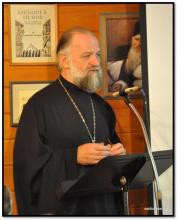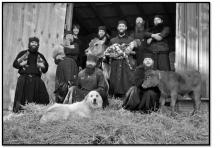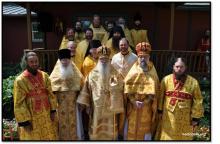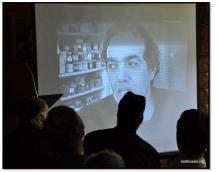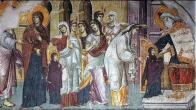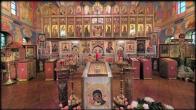Our Parish
You are here
08.23.10. "Contact with the Russian monastic tradition is undoubtedly helpful in our country for all those thirsting for a health spiritual life." An Interview with Archpriest Victor Potapov
On Monday, August 9, the feast day of the holy great martyr and healer Panteleimon, diocesan media office correspondent Reader Peter Lukianov procured an interview in Holy Cross Monastery with Archpriest Victor Potapov, dean of the South and rector of St. John the Baptist Cathedral in Washington, DC, on Fr. Victor’s impressions on his first visit to the monastery. The interview is available to our readers below, along with pictures of everyday life in the monastery.
- Father Victor, what are your thoughts as you return home from your first pilgrimage to Holy Cross Monastery? What are your impressions of this monastery?
This was our first visit to the monastery, and Matushka and I are returning from it with a feeling of deep spiritual joy. Over the three days spent here, we were able to participate in the rich liturgical life of the monastery brotherhood, festally glorifying the Lord at the divine services of the "Little Pascha" on Sunday, and on the day of the holy God-pleaser, the great martyr and healer Panteleimon, which is marked here as the second patronal feast day. The monks sing beautifully. The order of divine services is very strictly kept here in the monastery, but, supported by God’s grace, we did not feel any exceptional fatigue.
The only thing for which I am sorry as I depart from Holy Cross Monastery is that it is such a great distance from Washington (almost eight hours by car), and for that reason, unfortunately, we will not be able to come here often.
What made a great impression on me was the openness and affability of the monastics, and the ease with which one could speak with them. The brethren did everything possible to make our stay at the monastery comfortable. This attitude, by the way, was shown not only to me, but to every pilgrim without exception. Sincere and warm hospitality is a wonderful quality of the monks here, and I very much hope that they preserve it. This is a necessity when dealing with laymen who come to the monastery thirsting for spiritual comforting.
It was pleasant to observe the remarkable cleanliness here, despite the fact that the monks basically live in the woods. The monastery roads are not paved, but the church, the buildings, and the workshops are all kept in ideal order. Everything feels as if each monk cares for the monastery property as though it were his own domain.
Every monk and novice is assigned a specific and important obedience, on the completion of which rests the well-being of the others. Inasmuch as I can tell, the brethren fulfill their obediences with the utmost scrupulousness and, most importantly, in prayer. How else could one explain the exemplary order that is kept here?
And there are a multitude of obediences. The monastery operates an apiary, a small candle factory, a hennery, a farm with several cows and goats, and a large garden. The largest undertaking is the manufacture of a wide variety of incense, for which there is demand not only in America, but in Europe and even in Russia. There is a growing production at the monastery of sweet-smelling soaps, both liquid and solid. The incense and soap can be ordered on the monastery’s website. It is by these means (that is, thanks to the sale of incense and soap) that the monastery survives.
- This year Holy Cross Monastery celebrated its ten-year anniversary in West Virginia – in the Eastern American Diocese. Over these ten years, the Hermitage of the Holy Cross became a flourishing monastery and one of the principal spiritual centers of our diocese. In 2009, the official residence of Bishop George of Mayfield was constructed at the monastery and His Grace was elected abbot of the monastery. How would you evaluate the role of the Hierarch in the life of this monastery and in the general church life of the Deanery of the South?
I consider Bishop George’s residence within the walls of the monastery to be extremely important for the development of the spiritual life of Holy Cross Monastery. First of all, wherever there is a bishop, there is the fullness of God’s grace. Vladyka has a great deal of experience of life in Holy Trinity Monastery in Jordanville, which our Blessed Metropolitan Anastassy called the "Diasporan Lavra." His Grace took experience from this oldest monastery of the Russian Diaspora, which preserved the heritage of the Pochaev Lavra, Valaam, and other spiritual centers of Russia, and can pass along this spirit to the monks here.
Bishop George was born in the U.S. and converted to Holy Orthodoxy at a mature age, as did almost all of the brethren of Holy Cross Monastery. Neither His Grace nor the brethren need to overcome any cultural or ethnic barriers to have true spiritual communication between them. They all have similar spiritual biographies. This also applies in equal measure to the other parishes and missions of the Deanery of the South. Many communities in our region are comprised of people who converted to Orthodoxy at a mature age, and as a result Bishop George is especially close to them, someone to whom they can turn for advice and resolution of vexing issues of church life.
We lived at Vladyka’s house for the three days of our stay. I am grateful to His Grace, Bishop George, for the hospitality he showed us in his cozy home and am glad that we had an opportunity to speak closely with him and get to know one another better.
- How do you envision the future of this monastery?
I am, of course, not a clairvoyant, and cannot predict the future of the monastery, but I believe that if the monks will support a healthy spirit of true monastic life, about which I spoke earlier, the monastery will be fated to grow, flourish, and become an important spiritual center not only for our Eastern American Diocese, but for the whole Orthodox Church in the United States. On St. Panteleimon’s Day, priests came to the monastery from other jurisdictions and readily shared with me the impressions made on them and their parishioners by the monastery.Contact with the Russian monastic tradition is undoubtedly helpful in our country for all those thirsting for a health spiritual life.
- Why did you decide to do a presentation namely about Brother Joseph?
First and foremost, because the monks of Holy Cross Monastery asked me to themselves. The monks of Holy Cross Monastery feel a spiritual kinship with Brother Joseph, as they also zealously adopted Orthodoxy. We and Matushka immediately and readily answered their invitation to visit, and we would never refuse to tell of the life and labors of the chosen of the Mother of God to any who wishes to know more about him.
Our parish in Washington has acquired some prominence as a result of its special reverence of Brother Joseph. We gather all that we can, every grain of the life of the faithful custodian of the Montreal Myrrh-Streaming Iveron Icon of the Mother of God. Our cathedral has an exact copy, placed in an icon-case from Brother Joseph’s apartment, and given to us by the Icon’s House in Montreal after his tragic death in 1997. The icon being kept in our cathedral was written by the Athonite Archimandrite Chrysostom, the iconographer who wrote Brother Joseph’s myrrh-streaming icon. Matushka and I were well-acquainted with Brother Joseph, and many of the holy relics he owned, as well as his personal affects, are being temporarily kept in our home. We brought a portion of these holy relics to the monastery, so that the brethren might venerate them. For three hours, Matushka and I did our presentation and answered many questions in a hall filled to capacity, and we were overjoyed to see everyone’s sincere interest.
We also brought with us to the monastery cotton with myrrh from the "Hawaiian" myrrh-streaming Icon of the Mother of God, which was brought to our parish by Nectarios Yangston, the custodian of this new holy image. The Hawaiian Icon is a copy of the Montreal Iveron myrrh-streaming icon, which in the fall of 2007 (in the year of the unification of the Russian Orthodox Church!) began to gratuitously stream myrrh. Nectarios is sure that the new myrrh-streaming Iveron Icon is mysteriously tied to Brother Joseph and his labors in serving the Mother of God, and was given by God in order that the faithful would not forget about that miracle in Montreal in 1982 and its main participant – Brother Joseph.
Media Office of the Eastern American Diocese
PARISH LIFE
RECENT VIDEOS
Address of our Cathedral
Subscribe to our mailing list
While all the materials on this site are copyrighted, you may use them freely as long as you treat them
with respect and provide attribution on the Russian Orthodox Cathedral of St.John the Baptist of Washington DC.


